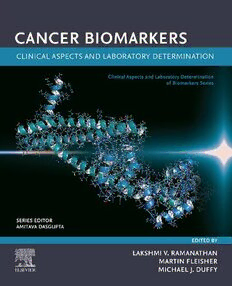
Cancer Biomarkers: Clinical Aspects and Laboratory Determination PDF
Preview Cancer Biomarkers: Clinical Aspects and Laboratory Determination
Cancer Biomarkers: Clinical Aspects and Laboratory Determination Clinical Aspects and Laboratory Determination ofBiomarkers Series Series Editor: Amitava Dasgupta Volume1 Alcohol and itsBiomarkers: Clinical Aspectsand Laboratory Determination Volume2 Biomarkers inInborn Errors ofMetabolism: ClinicalAspects and Laboratory Determination Volume3 Endocrine Biomarkers: Clinical Aspects and Laboratory Determination Volume4 Kidney Biomarkers:Clinical Aspects andLaboratory Determination Volume5 Cancer Biomarkers: Clinical Aspectsand Laboratory Determination Cancer Biomarkers: Clinical Aspects and Laboratory Determination Edited by Lakshmi V. Ramanathan Department of Pathology and Laboratory Medicine, Memorial Sloan Kettering Cancer Center, New York, NY, United States Martin Fleisher Department of Pathology and Laboratory Medicine, Memorial Sloan Kettering Cancer Center, New York, NY, United States Michael J. Duffy UCD School of Medicine, Conway Institute of Biomolecular and Biomedical Research, University College Dublin, Dublin, Ireland; UCD Clinical Research Centre, St. Vincent’s University Hospital, Dublin, Ireland Elsevier Radarweg29,POBox211,1000AEAmsterdam,Netherlands TheBoulevard,LangfordLane,Kidlington,OxfordOX51GB,UnitedKingdom 50HampshireStreet,5thFloor,Cambridge,MA02139,UnitedStates Copyright©2022ElsevierInc.Allrightsreserved. Nopartofthispublicationmaybereproducedortransmittedinanyformorbyanymeans,electronic ormechanical,includingphotocopying,recording,oranyinformationstorageandretrievalsystem, withoutpermissioninwritingfromthepublisher.Detailsonhowtoseekpermission,further informationaboutthePublisher’spermissionspoliciesandourarrangementswithorganizationssuch astheCopyrightClearanceCenterandtheCopyrightLicensingAgency,canbefoundatourwebsite: www.elsevier.com/permissions. Thisbookandtheindividualcontributionscontainedinitareprotectedundercopyrightbythe Publisher(otherthanasmaybenotedherein). Notices Knowledgeandbestpracticeinthisfieldareconstantlychanging.Asnewresearchandexperience broadenourunderstanding,changesinresearchmethods,professionalpractices,ormedical treatmentmaybecomenecessary. Practitionersandresearchersmustalwaysrelyontheirownexperienceandknowledgeinevaluating andusinganyinformation,methods,compounds,orexperimentsdescribedherein.Inusingsuch informationormethodstheyshouldbemindfuloftheirownsafetyandthesafetyofothers,including partiesforwhomtheyhaveaprofessionalresponsibility. Tothefullestextentofthelaw,neitherthePublishernortheauthors,contributors,oreditors,assume anyliabilityforanyinjuryand/ordamagetopersonsorpropertyasamatterofproductsliability, negligenceorotherwise,orfromanyuseoroperationofanymethods,products,instructions,orideas containedinthematerialherein. ISBN:978-0-12-824302-2 ForInformationonallElsevierpublications visitourwebsiteathttps://www.elsevier.com/books-and-journals Publisher:StacyMasucci AcquisitionsEditor:PatriciaM.Osborn EditorialProjectManager:MatthewMapes ProductionProjectManager:SelvarajRaviraj CoverDesigner:BridgetHoette TypesetbyMPSLimited,Chennai,India Contents List ofcontributors..................................................................................................xv Preface....................................................................................................................xix Acknowledgments..................................................................................................xxi CHAPTER 1 Overview of traditional and nontraditional tumor markers..........................................................................1 Jieli Li, Qing H.Meng and LakshmiV. Ramanathan Objectives......................................................................................1 1.1 Introduction....................................................................................1 1.2 Definition and characteristics oftumor markers...........................2 1.3 Utilizationof serum tumor markers inmalignant and benign tumors.................................................................................4 1.3.1 Alphafetoprotein................................................................5 1.3.2 CEA.....................................................................................5 1.3.3 CA19-9................................................................................5 1.3.4 CA15-3/CA27-29................................................................6 1.3.5 CA125, HE4, ROMA score (risk of ovarian malignancy algorithm)........................................................6 1.3.6 Prostate-specific antigen and prostate-specific antigen derivatives..............................................................6 1.4 Understand FDA approvedand non-FDAapprovedtumor markers...........................................................................................7 1.5 Overview ofmethodologies for measurement of tumor markers................................................................................8 1.5.1 Clinical sensitivityand specificityoflaboratory tests....................................................................................12 1.6 Laboratory technologiesfor tumor marker measurement...........14 1.6.1 Immunoassay methodologies............................................14 1.6.2 Other types ofimmunoassays...........................................15 1.7 Technical limitations ofimmunoassays.......................................17 1.7.1 Standardization oftumor marker assays..........................17 1.7.2 Interferences inimmunoassays.........................................19 1.8 High-pressure liquid chromatography mass spectrometry..........21 1.9 Methods for detectingnontraditional and emerging tumor markers.........................................................................................23 1.9.1 Metabolomics andproteomics..........................................23 1.9.2 Molecular and companion diagnostics.............................24 v vi Contents 1.9.3 Liquid biopsy....................................................................25 1.10 Summary Points...........................................................................26 1.11 Futuredirection............................................................................27 References....................................................................................27 CHAPTER 2 Laboratory testing in pediatric cancer patients........31 Khushbu Patel, WilliamS. Phipps,Hung S. Luu and DineshRakheja Objectives....................................................................................31 2.1 Introduction..................................................................................31 2.2 Childhood leukemia.....................................................................33 2.2.1 Diagnosis...........................................................................34 2.2.2 Cell surface markers.........................................................35 2.2.3 Other biomarkers...............................................................36 2.2.4 Treatment..........................................................................40 2.3 Childhood lymphoma...................................................................41 2.3.1 Hodgkin lymphoma...........................................................41 2.3.2 Non-Hodgkin lymphoma..................................................42 2.3.3 Markers..............................................................................42 2.3.4 Treatment..........................................................................45 2.4 Brainand central nervoussystem tumors (gliomas)...................45 2.5 Neuroblastoma..............................................................................48 2.6 Wilmstumor.................................................................................51 2.7 Hepatoblastoma............................................................................53 2.8 Germ cell tumors..........................................................................55 2.9 Conclusionsand future directions................................................57 2.10 Summary points............................................................................58 References....................................................................................58 CHAPTER 3 Challenges with common laboratory tests in the adult cancer patient.........................................67 Samuel I.McCash and Melissa S. Pessin Objectives....................................................................................67 3.1 Introduction..................................................................................67 3.2 The effect of inflammationon laboratory results........................68 3.2.1 Fibrinogen.........................................................................69 3.2.2 D-Dimer............................................................................71 3.2.3 Ferritin...............................................................................71 3.2.4 Haptoglobin.......................................................................72 3.2.5 Procalcitonin.....................................................................73 3.2.6 Albumin andits effect on total calcium...........................73 Contents vii 3.3 Interferences producedby cancer................................................74 3.3.1 Monoclonalproteins.........................................................74 3.3.2 Choriogonadotropin..........................................................76 3.4 Physiologic changes duetocancertreatment..............................78 3.4.1 Menopause........................................................................78 3.4.2 Stem celltransplant...........................................................79 3.4.3 Bonemarrow recovery......................................................79 3.4.4 Filgrastim..........................................................................80 3.5 Preanalytical issues......................................................................81 3.5.1 Pseudohyperkalemia.........................................................81 3.5.2 Lactate dehydrogenase......................................................82 3.5.3 Hemolysis..........................................................................83 3.5.4 Contamination...................................................................83 3.6 Analytical issues...........................................................................84 3.6.1 Glucose-6-phosphate dehydrogenase................................84 3.6.2 Therapeutic antibodies......................................................85 3.6.3 Analytic sensitivity lower range.......................................86 3.6.4 Analytic sensitivity higherrange......................................87 3.7 Postanalytical issues.....................................................................88 3.7.1 Critical values...................................................................88 3.8 Conclusion and future directions.................................................89 3.9 Summary points............................................................................90 References....................................................................................90 CHAPTER 4 Thyroglobulin and thyroid cancer..............................93 WilliamS. Phipps, Andrew N. Hoofnagle, MaraY. Roth and Christopher M. Shuford Objectives....................................................................................93 4.1 Introduction..................................................................................93 4.2 Thyroid noduleevaluation and the limitedroleof preoperative serum thyroglobulin measurements........................94 4.3 Postoperative evaluation ofdifferentiated thyroid cancer............................................................................................99 4.4 Thyroglobulinin the monitoringof differentiated thyroid cancer..........................................................................................101 4.5 Utilizationof thyroglobulinautoantibodies assurrogate marker.........................................................................................104 4.6 The measurement of thyroglobulinby immunoassays and the challengeof autoantibodies.................................................106 4.7 Thyroglobulinmeasurementby massspectrometry using peptide immunoaffinity enrichment.................................108 viii Contents 4.8 Thyroglobulin measurement by mass spectrometry—toward harmonization.............................................................................111 4.9 Thyroglobulin measurement by mass spectrometry—other challenges...................................................................................114 4.10 Practical applicationof thyroglobulin measurement by mass spectrometry:a suggestedapproach..........................................114 4.11 Thyroglobulin measurement—future directions........................117 4.12 Conclusion..................................................................................117 4.13 Summary points..........................................................................118 References..................................................................................118 Further reading..........................................................................129 CHAPTER 5 PSA: role in screening and monitoring patients with prostate cancer.................................................131 SigridV. Carlsson, Kazunori Murata,DanielC. Danila and Hans Lilja Objectives..................................................................................131 5.1 Introduction................................................................................132 5.2 PSA: physiologicalfunctionand analyticalassay.....................132 5.3 PSA screeningtrials...................................................................135 5.4 Baseline PSAstudies and long-term risk oflethal prostate cancer..........................................................................................139 5.4.1 PSAvariation..................................................................139 5.4.2 PSAas aprognostic marker...........................................141 5.5 PSA asa tumor marker andscreening tool for prostate cancerand recommendations fromnational guideline groups..146 5.6 PSA-related blood biomarkers toimprove the specificity of PSAand rule outthe need for prostate biopsy.....................148 5.6.1 PSAforms.......................................................................148 5.6.2 Biomarkers toimprove the specificityofPSA..............149 5.6.3 4-Kallikreinpanel...........................................................150 5.7 Methodsof detecting PSA.........................................................155 5.8 Role ofPSA inmonitoring disease recurrence and progression.................................................................................157 5.9 Conclusionsand future directions..............................................159 Conflict ofinterest declaration..................................................160 References..................................................................................160 CHAPTER 6 Monoclonal gammopathy detection and current technologies..............................................................173 Shelby M. Hutcherson and Katie L. Thoren Objectives..................................................................................173 6.1 Introduction................................................................................173 Contents ix 6.2 Monoclonal gammopathies........................................................174 6.3 Currenttechnologies for M-protein detection...........................178 6.3.1 Serumprotein electrophoresis........................................178 6.3.2 Immunofixation and immunosubtraction.......................180 6.3.3 Urine protein electrophoresisand immunofixation........182 6.3.4 Free light chain quantitation...........................................185 6.3.5 Testingguidelines...........................................................186 6.4 New andemerging technologiesfor M-protein detection.........187 6.4.1 Shiftassays......................................................................189 6.4.2 Mass spectrometry..........................................................191 6.4.3 Currentstatus andpotential role ofmass spectrometry for M-protein detection.............................195 6.5 Summary Points.........................................................................197 6.6 Future directions.........................................................................197 References..................................................................................198 CHAPTER 7 Liquid biopsy as a cancer biomarker-potential, and challenges..........................................................203 Daniel C. Danila Objectives..................................................................................203 7.1 Introduction................................................................................203 7.2 Clinicalutility of liquid biomarkers..........................................204 7.3 Clinicaldevelopment and validation of liquid biomarkers.......205 7.3.1 Context ofuse.................................................................205 7.3.2 Analytical validation.......................................................206 7.3.3 Clinical qualification.......................................................206 7.4 Circulating tumor cells...............................................................207 7.4.1 Themorphology and characteristics ofcirculating tumorcells.......................................................................208 7.4.2 Detection methods..........................................................210 7.5 Circulating tumor DNA.............................................................221 7.6 Conclusion..................................................................................229 7.7 Summary points and future directions.......................................229 Further readings.........................................................................230 References..................................................................................230 CHAPTER 8 Chimeric antigen receptor T cells and management of toxicities: implications of biomarkers................................................................245 Kitsada Wudhikarn,Ana Alarco´n Toma´s, Kazunori Murata and Miguel-Angel Perales Objectives..................................................................................245 8.1 Introduction................................................................................246
